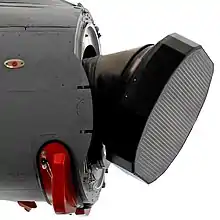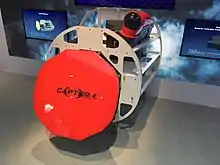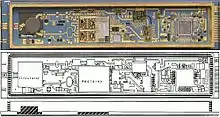Euroradar CAPTOR
The Euroradar Captor is a next-generation mechanical multi-mode pulse Doppler radar designed for the Eurofighter Typhoon. Development of Captor led to the Airborne Multirole Solid State Active Array Radar (AMSAR) project which eventually produced the CAESAR (Captor Active Electronically Scanned Array Radar), now known as Captor-E.
 Captor-E Demonstrator | |
| Country of origin | Germany, Italy, Spain, United Kingdom |
|---|---|
| Type | Captor-M: Solid-state, mechanically scanned array radar CAPTOR E: Active electronically scanned array (AESA) radar |
| Frequency | X-band |

Development
Development started as the ECR-90 at Ferranti's Edinburgh radar labs, home of many British radar systems. The ECR-90 was based on the Blue Vixen radar which had been developed for the BAE Sea Harrier FA2. The selection of the radar had become a major stumbling block in the EFA project, as the Eurofighter Typhoon was known at the time. Britain, Italy and Spain supported the Ferranti-led ECR-90, while West Germany preferred the MSD2000, based on the US AN/APG-65 radar family being developed in a collaboration between Hughes, AEG and GEC.
An agreement was reached after the British Defence Secretary Tom King assured his West German counterpart Gerhard Stoltenberg that the British government would underwrite the project and allow GEC to acquire Ferranti Defence Systems from its troubled parent.[1] Ferranti's labs became the new GEC Ferranti in 1990, and then BAE Systems Avionics when GEC's various military electronics divisions - Ferranti, Marconi and Elliott Brothers - were merged.
Hughes sued GEC for $600 million for its role in the selection of the EFA and alleged that it used Hughes technology in the ECR-90 when it took over Ferranti. It later dropped this allegation and was awarded $23 million; the court judged that the MSD-2000 "had a real or substantial chance of succeeding had GEC not [tortiously] intervened... and had the companies, which were bound by the Collaboration Agreement, faithfully and diligently performed their continuing obligations thereunder to press and promote the case for MSD-2000."[2]
Since these events, further mergers have taken place in the industry. Parts of BAE Systems Avionics were merged with Galileo Avionica to form SELEX Galileo in 2005 which in turn then merged with other Finmeccanica defence electronics companies in 2013 to create Selex ES (merged in turn in Finmeccanica, rebranded Leonardo since 2017). The development effort is now organized under the Euroradar consortium, consisting primarily of Selex ES,[3] as well as Airbus and Indra.
The ECR-90 was renamed CAPTOR when the project passed the production contract milestone.[4]
Captor-E AESA variant

In 1993 a European research project was launched to create the Airborne Multirole Solid State Active Array Radar (AMSAR); it was run by the British-French-German GTDAR ("GEC-Thomson-DASA Airborne Radar") consortium (now Selex ES, Thales and Airbus respectively).[5] This evolved into the CAESAR (Captor Active Electronically Scanned Array Radar), now known as Captor-E Active electronically scanned array.[5]
In May 2007, Eurofighter Development Aircraft 5 made the first flight with the a prototype of the Captor-E.[6] The Captor-E is based on the Captor radar currently in service on Eurofighter production aircraft. The new generation of radar is intended to replace the mechanically steered antennas and high-power transmitters used on current Eurofighter aircraft with an electronically steered array This enables new mission capabilities for combat aircraft such as simultaneous radar functionalities, air surveillance, air-to-ground and weapon control. The new radar improves the effective air-to-air missile range of the aircraft and allows for faster and more accurate detection and tracking of multiple aircraft with lower life cycle costs.[6] In July 2010, it was reported that the Euroradar consortium made a formal offer to provide an AESA solution for the Eurofighter. The consortium plans to retain as much "back-end" equipment as possible while developing the new radar and also stated that the inclusion of an AESA radar was an important in securing orders from foreign nations.[6]
On 19 November 2014, at the Edinburgh office of Selex ES, the European consortium Eurofighter GmbH and the inter-governmental agency NETMA (NATO Eurofighter and Tornado Management Agency) signed a contract worth €1 billion to develop the electronically scanned digital antenna array Captor-E radar for the Typhoon.[7]
Characteristics of the antennas:
- Captor-M: Mechanically scanned antenna. Interface and integration of the radar to the aircraft by BAE Systems
- Captor-E ECRS Mk0: Interface and integration of the radar to the aircraft by BAE Systems.[8] AESA antenna, the T/R modules are made with GaAs HEMT HPA (gallium arsenide High Electron Mobility Transistor High Power Amplifiers)
- Captor-E ECRS Mk1: Interface and integration of the radar to the aircraft by Airbus Germany.[8] AESA antenna, the T/R modules are made with GaAs HEMT HPA (gallium arsenide High Electron Mobility Transistor High Power Amplifiers)
- Captor-E ECRS Mk2: Interface and integration of the radar to the aircraft by BAE Systems.[8] AESA antenna, the T/R modules are made with GaAs and GaN HEMT HPA (gallium arsenide and gallium nitride High Electron Mobility Transistor High Power Amplifiers). This enables efficient multi-tasking of radar tracking use and electronic warfare simultaneously.[9] It is installed on a pivot derived from the one used on the Gripen E with the Selex ES-05 Raven radar. And the wider bandwidth meant that a new radome was needed.[10]
Operators
Captor-M
571 aircraft fitted with this radar.
- Austrian Air Force – 15 radars and 3 ordered (Tranche 1)[11]
- German Air Force – 143 radars (Tranche 1 - Tranche 3)
- Italian Air Force – 96 radars (Tranche 3)
- Royal Air Force of Oman – 12 radars (Tranche 1 - Tranche 3)[12]
- Royal Saudi Air Force – 72 radars (Tranche 2 - Tranche 3)
- Spanish Air and Space Force – 73 radars (Tranche 1 - Tranche 3)
- Royal Air Force – 160 radars (Tranche 1 - Tranche 3)
Captor-E ECRS Mk0
52 aircraft will eventually be fitted with this radar.
- Kuwait Air Force – 6 radars in service, 22 more on order as of September 2022 (Tranche 3)[13][14]
- Qatar Emiri Air Force – 10 radars in service, 14 more on order as of March 2023 (Tranche 3)[15][16]
Captor-E ECRS Mk1
Over 150 aircraft should eventually be fitted with this radar, some retrofitted.
- German Air Force – 38 radars to equip the Tranche 4 "Quadriga" [17] Initial deliveries will be of the Mk 0 radar
- German Air Force – 110 radars on order for the modernisation of the Tranche 2 and 3 [18]
- Spanish Air and Space Force – 20 radars to equip the Tranche 4 "Halcon" [17]Initial deliveries will be of the Mk 0 radar
- Spanish Air and Space Force – 5 radars on order for the modernisation of the Tranche 3 [18]
Captor-E ECRS Mk2
At least 40 aircraft will eventually be fitted with this radar, up to160 aircraft (depending on Germany and the UK's decisions).
![]() United Kingdom – Royal Air Force[19]
United Kingdom – Royal Air Force[19]
- 40 radars on order for the modernisation of the Tranche 3
- Potential order for Tranche 2 (up to 67 aircraft)
- German Air Force – Discussions to shift from the Mk1 variant to the Mk2 with the 15 (up to 30) Eurofighter ECR that might be new or based on an existing aircraft
- German Air Force – Discussions to shift from the Mk1 variant to the Mk2 with the Tranche 4 "Quadriga" [20]
See also
References
- Miller, Charles (1990-05-08). "Radar Deal Keeps Britain in Forefront of Airborne Technology". The Press Association Ltd.
- "Court finds GEC 'intervened' on behalf of onetime EFA rival Ferranti". Aerospace Daily. McGraw-Hill Inc. 1994-03-15. p. 398.
- Hoyle, Craig (15 July 2010). "Eurofighter nations offered AESA radar enhancement". Flightglobal.
- "Eurofighter Typhoon". airpower.at (in German). Retrieved 18 November 2015.
- "The Three Musketeers: Europe's next-gen fighter radars". Jane's International Defense Review. June 1, 2013.
- "Radar Captor-E". Leonardo.
- "Eurofighter radar deal secures 500 jobs in Edinburgh". BBC News. 19 November 2014. Retrieved 18 November 2015.
- https://www.hensoldt.net/fileadmin/HENSOLDT_2019/Products/Radar_IFF_Datalink/0717_14_Captor_E.pdf
- "Le premier radar ECRS MK2 !". Avia news (in French). 2023-04-21. Retrieved 2023-06-21.
- Lake, Jon. "Britain's Long-awaited Radar Two Program Breaks Cover". Aviation International News. Retrieved 2023-06-21.
- "Drei neue Eurofighter für das Heer". Die Presse (in German). 4 October 2022.
- "Oman completes Typhoon deliveries". Times Aerospace.
- "Take a Look at These Cool Photos of the Delivery Flight of the Kuwait Air Force's First Eurofighter Typhoons". The avionist. 15 December 2021.
- "وصول الدفعة الثالثة من طائرة اليوروفايتر تايفون إلى أرض الوطن". Al anba (in Arabic). KW. 28 September 2022.
- Cenciotti, David (27 August 2022). "First Batch Of Eurofighter Typhoon Aircraft Delivered to Qatar". The Aviationist. Retrieved 19 May 2023.
- "Displaying Serials in range ZR". ukserials.com. Retrieved 19 May 2023.
- "Future proofing the Eurofighter Typhoon. | HENSOLDT". www.hensoldt.net. Retrieved 2023-06-21.
- www.airbus.com https://www.airbus.com/en/newsroom/press-releases/2020-06-airbus-signs-contract-for-integration-of-115-new-eurofighter-escan. Retrieved 2023-06-21.
{{cite web}}: Missing or empty|title=(help) - "First ECRS Mk2 radar for UK Typhoon fleet delivered to BAE Systems for integration". www.leonardo.com. Retrieved 2023-06-21.
- https://www.armadainternational.com/2020/10/beam-scheme/